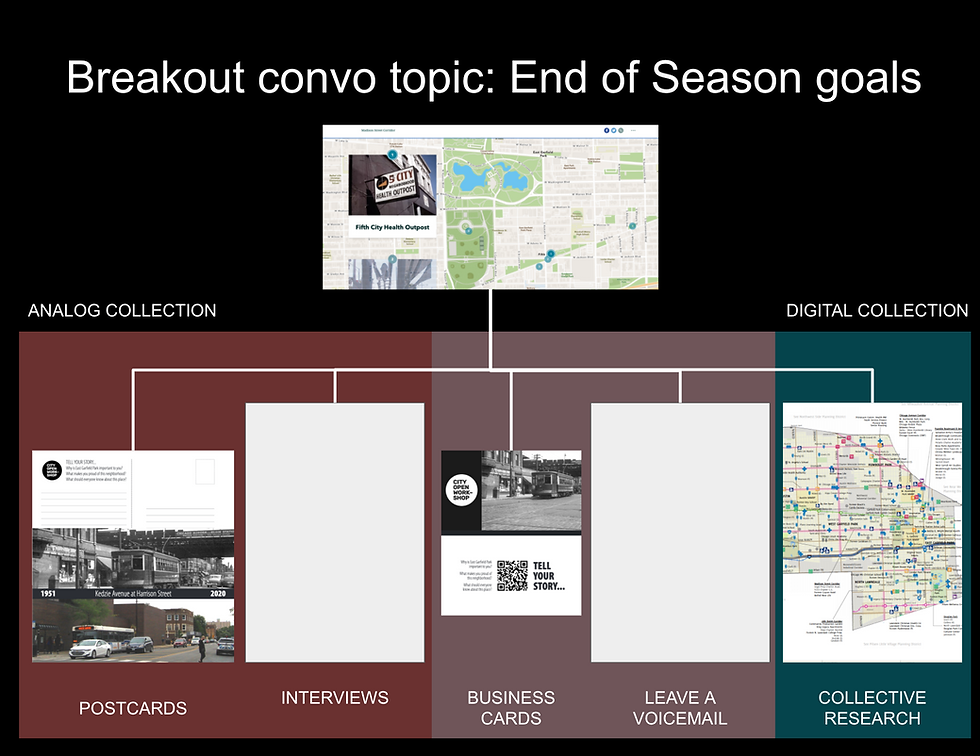Spring 2021 – Workshop #4: How do we engage (the) Community?
- Tom Martin
- Apr 7, 2021
- 4 min read
Spring has arrived — the sun is out, the thaw is complete, and there is a hop in our collective step. Conversations are shifting from ‘what’ and ‘if’, to ‘how’ and ‘when’. This seasonal shift and embrace of the ‘how’ felt particularly pertinent during Workshop #4.

Image description: Draft of the front and back of a postcard for the workshop discussion. The front, on the left, shows a 1951 photo taken at Kedzie Avenue and Harrison. On the right, the mostly blank back of postcard with text saying “TELL YOUR STORY…”
Following a two-week detour into Mentimeter based introductions, the group returned to vocalized introductions centering on what everyone collects. Answers included fantasy novels, shells, taxidermy, and seeds. After a useful reminder of CityOpen’s values and methodologies, the basis of this season’s work in Garfield Park, as well as a brief overview of this season’s prompt — how do we imagine more inclusive and meaningful planning and visioning processes for historically disinvested neighborhood corridors? — our guest speaker, Al Walker, was given the floor.
Al is a familiar face to CityOpen Workshop as a member of the advisory team and reliable workshop participant. Beyond their connections to CityOpen, Al is a leader with Chicago Sustainability Leaders Network (CSLN) an organization that “connects grassroots leaders from communities across Chicago to share resources, support each other’s work, collaborate, build a stronger collective voice, and nurture equitable and impactful relationships with policy makers.”
Central to CSLN’s founding was the Institute of Cultural Affairs’ (ICA) accelerate77 program, which proposes to accelerate growth within Chicago’s 77 communities by focusing on assets already present in a given community. For seven years CSLN has carried out these initiatives, which have aided in the development of several more localized groups like the Garfield Park Conservatory Alliance, who aim to grow their community with a focus on their green space assets.
You may ask yourself — how do CSLN and affiliated groups identify assets within a community? Simply put; ask the community. CSLN partners with these localized groups to host “Nourishing Community Events” where leaders and neighbors alike participate in a facilitated conversation regarding the current issues facing their community and assets that may help in addressing these issues. CSLN’s access to municipal resources and City officials provides a framework for addressing these issues and furthering investment in community assets.

Image description: Screenshot from Al Walker’s presentation showing Al sitting with two other people presumably listening to a presentation.
A common asset that is often in need of investment are burgeoning local businesses. Two Garfield Park examples shared were the Westside Bee Boyz, an organization that utilizes a holistic approach to beekeeping to improve community, and Inspiration Kitchen, an organization that helps train low-income and homeless Chicagoans in the foodservice industry. These businesses and organizations are essential to the vitality of a neighborhood. Al put it succinctly towards the end of their presentation by saying “all communities have assets.” A crucial shift in perspective and approach for this season and beyond.
We then split up into two breakout groups to discuss strategy tools for data collection: Digital Framework + Analog Framework. The digital framework group’s focus was on using storymapping as a tool, where images and descriptions/stories can be geolocated on a map using GIS. The conversation also touched on how assets beyond the physical borders of the neighborhood, like the United Center, can be viewed and utilized as assets. Can transit and other resources be leveraged more to better connect Garfield Park to these assets within and adjacent to the neighborhood? And how does the physical Garfield Park differ from the neighborhood of Garfield Park? Perhaps these are questions that can be investigated through digital storymapping, which may offer insights into physical connections and barriers.

Image description: Snip from the presentation with the slide titled “Breakout convo topic: End of season goals.” A tree diagram with an image from the storymapping site at the top, that splits into 5 different collection tools: postcards, interview, business cards, leave a voicemail, and collective research.
The analog framework group’s conversation started with the concept of in person interviews. Considering availability and comfort, the group pivoted to the ideas of long distance postcards, QR codes leading to online feedback, and voicemails as alternative methods of gathering stories and data. The postcards would be pre-stamped and provide space for neighbors to describe their Garfield Park story. The QR code would link back to an online platform to provide feedback/insight. Finally, physical business cards could be distributed to the community outlining a phone number that would compile voicemails from residents. Having a variety of methods provides ample flexibility and a higher likelihood for broad feedback.
The success of our data collection is contingent upon how accessible these methods are and how open we are to listening. It’s abundantly clear that Garfield Park is rich in community assets; our job must be to provide the platform for the community to shed light on these assets.
Tom Martin is a landscape designer interested in equitable design, community engagement, and the untapped potential of alleyways



























Comments